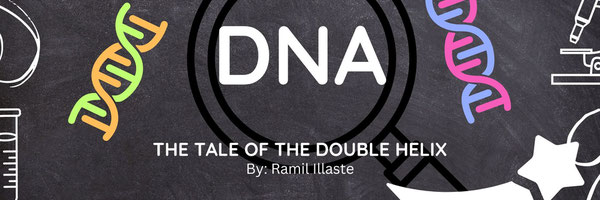DNA: The tale of the double helix
Ramil Illaste
Grade 7
Presentation
No video provided
Problem
DNA is known all around the world given its importance to all living things, but how much do we really know about Deoxyribonucleic acid? I want to look deep into DNA and learn about its uses and what we can do with it. Also how our envirnoment changes it over our lifetime. I will also discuss mutations and different diseases.
Method
I will be reasearching through videos and websites about DNA.
Research
What is it?
DNA (also known as Deoxyribonucleic acid) is essentially the blueprint for any living organism. DNA is made of 2-3 parts (taking the shape of a double helix), these parts including the sugar/phosphate backbone and the nitrogenous bases. There are 4 different nitrogenous bases, A (adenine), T (thymine), G (guanine), and C (Cytosine). A single DNA strand consists of 2 backbones, each with multiple nitrogenous bases. The two halves are connected with each other through these bases. Although, there are a few rules, A must connect to T and G must connect with C.
What is it used for?
DNA is used for making RNA which then makes proteins in the living cell. Inside the nucleus of a living cell, there is a chemical which takes small strips of DNA and copies one side of it. This is the process of making RNA (Ribonucleic acid). The RNA goes through small openings in the nucleus and goes to the cytoplasm. Then, it goes out to a Ribosome which looks at the RNA three letters (of the RNA) at a time. Each three letters tells the ribosome which amino acid to build. After the RNA is finished, the ribosome would have made a full protein.
How similar is DNA?
Humans have 99.9% shared DNA, the other 0.1% is what makes us different from others. People can use fingertips, spit and many other things in forensics, because no humans are the exact same. Humans also share over half of our genetics with bananas, fruit flies, and chicken's. This is because living beings all have to have "housekeeping genes", these include DNA replacement, controlling cell cycles and many basics for staying alive.
What are mutations?
Mutations are changes in the DNA arrangement of a living thing. There are many types of mutations including but not limited to: frameshift mutation, nonsense mutation, deletion, and many more. Mutations happen from either problems during DNA replacement or getting damaged by chemicals and radiation.
What are Epigenetics
Epigenetics is the study of how changes like your environment and behaviors can cause changes in the way your genes work. Epigenetics change the way your body reads your DNA arrangement. There are multiple epigenetic changes including: DNA methylation, Non coding RNA, and Histone modification. Changes that can lead to this include: Diet, Obesity, alcohol consumption, and things like that.
Data
I wiil not be collecting any data on this but just presenting research on dna
Conclusion
Acknowledgement
I would like to thank Ms Watson for her help and supervision in working on this project.

